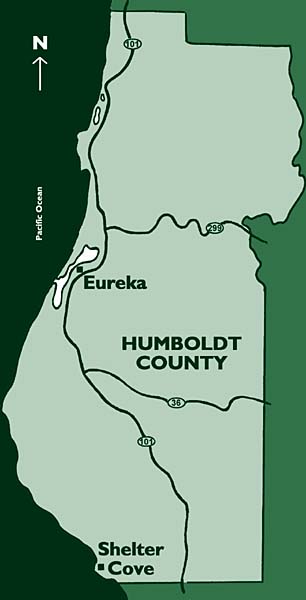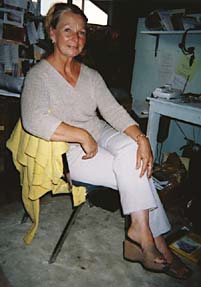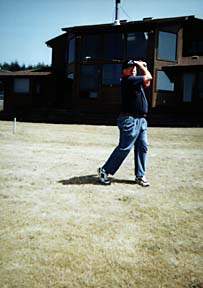|
 
COVER
STORY | GOOD
NEWS | GARDEN | PUBLISHER | CALENDAR
Sept. 4, 2003
THE
WEEKLY WRAP
by
Hank Sims
SUSPICIOUS BLAZE... A 4-month-old Fortuna infant died, and his
17-month-old brother was severely injured, when a suspicious
fire destroyed half of their Perras Court duplex, the Sheriff's
Office reports. Their mother had escaped through a window, and
was treated and released from a local hospital, but the two children
were removed from the burning building by members of the Fortuna
Fire Department shortly after midnight Saturday and airlifted
to a burn center in the Bay Area. The baby died Saturday afternoon.
The county's Arson Task Force is investigating. Meanwhile,
a 21-year-old man was stabbed around 2 a.m. Monday morning on
Fortuna's Main Street, in an altercation between two groups of
young men. All suspects were "wearing blue sports jerseys
and blue bandanas," the Fortuna Police said. Hmm, gangs
perhaps?
HARVEST SEASON HEATS UP...
With late August marking the beginning
of the annual season of paranoia and violence in
the county's alternative agricultural production zones, tragedy
struck Southern Humboldt last week. The body of Sean Thomas-Butler
Akselsen, 18, was found near Briceland, dead of a gunshot
wound. A private investigator retained by Akselsen's family believes
that the murder is most likely the result of a drug deal gone
bad, and the Sheriff's Office wants to interview three African-American
males seen around the Garberville-Redway area the weekend of
Aug. 23-24. The three were said to be traveling in a dark green,
late `80s model Chevy Camaro.... Meanwhile, SoHum medical marijuana
activist Chris Giauque, last seen on Spy Rock Road
three weeks ago, was still missing, and his family and the
Sheriff's Office were still hoping for people to come forward
with information that could help them find him. In a bittersweet
footnote to the case, a federal judge ruled last week
that an ounce of marijuana the Sheriff's Office confiscated from
Giauque in 1999 should be returned to him... In a further pot-related
development, the Campaign Against Marijuana Planting announced
that it had seized more than 10,000 plants since the beginning
of August, including a large indoor bust in the China Creek
area last week. Oh, and a hashish laboratory
in Arcata exploded.
TOWER TRIUMPH... The Arcata Bottom's sizable contingent of anti-cell
tower activists scored a big victory when Cal-North Wireless
announced that it had dropped plans to build an antenna tower
in the neighborhood. The company's decision followed a less-than-favorable
hearing at the Board of Supervisors, where swing supe
Jimmy Smith joined John Woolley and Jill Geist
in voting to deny immediate approval of the tower. Next up: U.S.
Cellular's plan for a tower on Sun Valley Floral
Farms property (For a good primer on the whole cell phone
issue, even if we do say so ourselves, see our Aug.
14 cover story, "Cellular Division").
OUCH... The ever-busy Lindsey McWilliams, county
elections officer, said that his office was in receipt of a new
batch of petitions -- these on a proposed state initiative that
would make it easier for the state Legislature to pass new taxes.
If word comes down from the state, as it could at any moment,
the county's elections staff will have to verify the 14,000
signatures on the petitions. On top of that, McWilliams heard
from Gallegos recall people that they were close to completing
their goal of 11,000 signatures. McWilliams fears that the way
things are going, these two things may happen simultaneously
-- putting the elections office into "a world of hurt,"
as he put it.
GET OUT THOSE SHOVELS...
The Federal Highway Administration
awarded $72 million in emergency funds to the effort to rebuild
Highway 101 near Confusion Hill. The perilous stretch
of road slid out several times last winter, leading to long delays
and, in a few cases, complete closure of the highway. The only
hitch: The entire project, which would likely involve moving
the stretch of highway to the other side of the canyon, will
have to be completed by 2008, or the federal money disappears.
CALPINE was back in the area, talking with the Greater
Eureka Chamber of Commerce about its plans to build a liquefied
natural gas entrepot and power plant somewhere on
Humboldt Bay. The Environmental Protection and Information
Center pledged to fight the project.
LAWRENCE WIESNER, the Santa Rosa accountant who lost to Mike Thompson
in last year's 1st District congressional race, is going
to be touring the lower Klamath this Saturday. According
to a press release, the Republican is "concerned about the
hysteria of some of the so-called environmentalists who through
the application of pseudo-science have caused grave injury to
the farmers in the Klamath Basin." Evidently Wiesner is
gearing up to challenge Thompson again next year -- but why is
he stumping for Oregon votes?
COASTAL COMMISSION MEETS...
The September meeting of the California
Coastal Commission takes place at the Eureka Inn, Wednesday,
Sept. 10 through Friday, Sept. 12. Since the commission only
makes it to Humboldt County once a year, the Eureka Chamber of
Commerce will hold a meet-and-greet dinner for commissioners
at 5:30 p.m. Thursday at O-H's Townhouse in Eureka. Cost: $35
per person. Call for reservations by Sept. 4.
CORRECTION... A story
in the Aug. 21 issue misstated the professional position held
by David A. Neumann. He is the executive director of the
National Partnership for Immunization.
SECOND OF TWO PARTS:
Boom Time
Its troubled past largely forgotten,
Shelter Cove is going gangbusters
(Part
One in Aug. 28 edition)
by GEORGE RINGWALD
 Linda Yates, real estate broker
for Lost Coast Properties, remembers that "it was very quiet
here" when she moved to Shelter Cove from Lake Tahoe in
1966. "There were hundred of lots for sale," she notes.
"And it took me almost a year to make my first sale. Linda Yates, real estate broker
for Lost Coast Properties, remembers that "it was very quiet
here" when she moved to Shelter Cove from Lake Tahoe in
1966. "There were hundred of lots for sale," she notes.
"And it took me almost a year to make my first sale.
"It really
did not take off until 1998, and then `99 was very busy; 2000
I would call a feeding frenzy. People were just coming in and
wanting to write offers. At times you didn't even have to go
out and show property. There were so many people coming in and
out, looking at real estate, wanting maps, listings of lots.
What a contrast to `96 when there were just 30 homes on the market,
and priced around $100,000. Now, it is difficult to find a home
under $300,000."
She adds, "Lots
have basically doubled in price, especially view lots. There
are a lot of nice building lots still on the market in the $20,000
to $35,000 price range."
From January
through July of this year Humboldt County has issued 12 building
permits for new homes in Shelter Cove, with a total valuation
of nearly $1.2 million.
The word is
out all over the Cove -- it's boom time.
Not
perfect
Shelter Cove
is not without its problems.
Approximately
15 percent of the mammoth subdivision's lots -- from 400 to 500
parcels -- are unbuildable because the original developers sited
them on overly steep terrain. Many of those properties are routinely
put up for public auction by the county because their owners
haven't paid property taxes in five years or longer. Some are
currently being offered for sale on the Internet, where an unsuspecting
buyer, dazzled by the spectacular photos of the area, could very
well end up with an unusable piece of land (see "The Shelter
Cove Saga, Part I: From land scam to popular resort," Aug.
28).
Be that as it
may, the vast majority of the lots are usable -- and an increasing
number are getting built on.
"Last year
we were having this increase in building permits," says
Roger Boedecker, president of the Shelter Cove Resort Improvement
District (RID). "I am surprised that the growth continues
into this year."
The Resort Improvement
District, which functions as a city council does in incorporated
cities, serves 383 paying customers. It picked up 32 new customers
last year. "And we are at a rate this year of making the
same figure," said Boedecker. "I would anticipate in
the year 2015, if we continue at the same rate, we will be pushing
1,000 developed properties."
Looking ahead,
Boedecker sees there might be problems down the road to maintain
the adequate infrastructure of sewage treatment, water supply,
fire service and utilities. "If we continue to have building
as we're having now," he said, "we could be approaching
some limits in 10 years."
Changes
in works
Meanwhile, however,
the district is pushing ahead with plans for a children's playground
in the community center, an adjunct to the fire station.
Some Cove old-timers
marvel at the community's present growth boom.
 "Ten
years ago, it was a very peaceful place," muses Herb Zastrow
[photo
at right] , a bustling
81-year-old who, with his wife, Chris, manages the Shelter Cove
Motor Inn. "The town was hard to get to. We didn't have
many visitors. There were three motels here then [five now and
a sixth under construction], and the most units they had was
10. In those early days it was nip and tuck to get people back
in here, because nobody knew about the Lost Coast at that time,
and I mean, it WAS lost. I think basically what has really put
us on the map in the last four, five years is the computer --
our ads on the Internet." "Ten
years ago, it was a very peaceful place," muses Herb Zastrow
[photo
at right] , a bustling
81-year-old who, with his wife, Chris, manages the Shelter Cove
Motor Inn. "The town was hard to get to. We didn't have
many visitors. There were three motels here then [five now and
a sixth under construction], and the most units they had was
10. In those early days it was nip and tuck to get people back
in here, because nobody knew about the Lost Coast at that time,
and I mean, it WAS lost. I think basically what has really put
us on the map in the last four, five years is the computer --
our ads on the Internet."
Zastrow, who
likes to remind you that the Shelter Cove Motor Inn has 16 guest
units (more than any other motel in town), will tell you: "We're
getting more and more business all the time. We're full probably
40 percent of the weekdays, and on the weekends we're booked
solid."
What happens
in the winter? "Very slow," he admits -- although people
do come on weekends, "to see the stormy seas."
Zastrow, who
previously lived in Shasta, has been coming down to Shelter Cove
on fishing visits for as long as 30 years. "Lots were very
reasonable at that time," he says. And they were still that
way when he took over the motel management in 1993.
"But all
of a sudden it's taken an upswing," he observes. "People
coming in, looking for a place where they can retire. And prices
have probably doubled in the last 10 years.
"We have
everything here than you can ask for -- except that we don't
have doctors, no dentists, you don't have supermarkets, no drug
store. We have the airport [landing strip], which is 3,200 feet
long. And we have access to Mercy Air, out of Redding, which
will fly over here and take you to the hospital."
The airport
runway, incidentally, also comes under RID's management.
"The air
strip is a day strip only," explains Richard Culp, general
manager of the Resort Improvement District. "It's for pilots
who come in with their own fuel to leave with. We have no fuel,
we have no lights, no instrumentation, it's often foggy, and
we have nobody to call to see if the weather's OK."
Past
tragedy
Shelter Cove
has good reason to take such precautions on the airport. The
memories are still vivid today -- 32 years later -- of the tragic
crash of a twin-engine DC-3 airliner as it tried to take off
from the runway, and wound up in the ocean. It was one of those
routine flights into Shelter Cove of salesmen hawking lots in
the budding resort. Seventeen people were killed in the crash,
and seven, remarkably enough, survived.
That 1971 tragedy,
of course, ended flights of the DC-3s or bigger aircraft.
Realtor Frances
Aldridge recalls: "We were there when that plane crashed.
My best friend was killed on that plane."
Love
of place
But what one
hears so frequently from Shelter Cove residents is not about
the problems, but about their love of the place.
 Diana
Cistaro [photo
at left] , who
together with her partner David Smollet, owns the Marina motel
and a first-class restaurant that overlooks the bay from which
fishing boats are launched, tells me: "I fell in love with
the place, coming over the hill. Shelter Cove is one of the most
interesting places you could ever imagine. Diana
Cistaro [photo
at left] , who
together with her partner David Smollet, owns the Marina motel
and a first-class restaurant that overlooks the bay from which
fishing boats are launched, tells me: "I fell in love with
the place, coming over the hill. Shelter Cove is one of the most
interesting places you could ever imagine.
"So many
different people from so many different places. And it seems
like at times people get a little bent with each other. They
may not talk to each other for five years, but if there's a crisis
here, everybody pulls together."
Cistaro came
to the Cove from Sacramento 11 years ago. She was married at
the time, and the two of them bought property to build on the
day after their arrival.
"Our house
looks like a little house that kids built," she says with
a laugh. "In fact, my ex-husband and his lady have the apartment
underneath where I live. They live in Stockton, but they come
and visit." Offhand, she mentions that she found the perfect
wife for her ex. "A beautiful woman, and they are absolutely
the perfect match."
She finds everything
in Shelter Cove dramatic, and certainly that's the word for the
winters here.
"They can
get really severe," she says. "We have the best of
the best and the worst of the worst when it comes to weather.
I've seen some hellacious weather here -- when the wind exceeds
70 miles an hour. The first month I moved here, in 1992, we had
three major earthquakes in a row, and I was terrified."
 Sam
Scott [photo
at right]
, an avid golfer who
lives off the fourth fairway of the local nine, got hooked on
Shelter Cove after getting marooned. "We came up here in
February [of 1986]. It had rained the week before and the week
after. There was a slide in Briceland; the road was closed and
we were trapped here for eight days -- in a little A-frame down
there on the ocean. And we thoroughly enjoyed the eight days
we were here. We were hooked. We came back in April and bought
the lots." Sam
Scott [photo
at right]
, an avid golfer who
lives off the fourth fairway of the local nine, got hooked on
Shelter Cove after getting marooned. "We came up here in
February [of 1986]. It had rained the week before and the week
after. There was a slide in Briceland; the road was closed and
we were trapped here for eight days -- in a little A-frame down
there on the ocean. And we thoroughly enjoyed the eight days
we were here. We were hooked. We came back in April and bought
the lots."
Scott, 61, a
retired engineer and operations manager for Hewlett Packard,
and his wife (they have since divorced but he enjoys occasional
visits from a daughter and granddaughter) paid $25,000 for the
two lots on which they erected an impressive home with white
walls, set off by panels of knotty cedar and a vaulted ceiling.
"It was
a bargain," Scott recalls. "For any kind of coastal
property, that was probably the most economical in California."
Ocean-front
lots
"Shelter
Cove is one of the few remaining places in California where you
can buy a lot on the ocean," says Stephen Strawn, treasurer
and tax collector for Humboldt County. "And there are some
beautiful homes. [About] 20 years ago I actually sold at tax
auctions some of these properties that houses now sit on, and
they sold for as little as $4,000 or $5,000. Now these lots,
when they are for sale, it's not unusual to ask $80,000 to $100,000
for the lot."
Sam Scott revels
in the Shelter Cove life. "I've never been bored in Shelter
Cove," he says. "There's always something to see --
planes coming in, and fishermen going out, always something going
on in the ocean."
For sheer grandeur,
there's nothing like the Ashbrook Inn, the bed and breakfast
that Temple Ashbrook and Loretta Hyatt-Ashbrook built high on
a hillside outside of Shelter Cove proper and overlooking the
Pacific Ocean.
Ashbrook, formerly
a construction project manager in Los Angeles, built most of
the three-level house himself, with the help of some high school
students. Hyatt-Ashbrook, who grew up in Tulare County, has a
degree in art from San Diego State University, and also taught
interior design at the junior college level.
They enjoy being
proprietors. "We have fun running this ourselves,"
Ashbrook said. "Meeting people is really delightful. We
clean the bathrooms. I do the gardening. We do the cooking together,
make the beds together.
"I enjoy
seeing other people enjoying their stay," he adds. "I
see them sometimes arrive a little tense, and very quickly they
become quite relaxed. They feel at home here. The B&B can
bring out a lot of skills about enjoying life."
Rates are a
bit steep -- in the $160 to $180 range -- but that hasn't deterred
people. "You put up a Web site and they just come,"
Hyatt-Ashbrook says.
Don't
expect Walmart
Real estate
broker Linda Yates goes out of her way to point out recent upgrades.
"Since
I've been here," she says, "we've put in a brand new
sewer plant, and the water is recycled now. We have three restaurants,
plus the deli and the coffee shop. The golf course is looking
great, the airport (runway) was just resealed. A lot of improvement."
One complaint
she hears: the lack of a shopping center. "It's interesting
to watch people when they come here. The men have a tendency
to like it more out here than the women, I think, simply because
of the outdoor activity, the remoteness. The [women] must be
near a mall."
I can't wait
to hear Cistaro's rebuttal. And the vivacious blond doesn't disappoint.
"People
want to know: What do you have to entertain us?" She looks
askance at the thought. She goes on: "Well, if you need
to be entertained, you may not want to come here, because you
have to be able to sit still and just let everything be around
you."
Longtime
Journal contributor
George Ringwald lives in Eureka.
The
battle that was
20 years ago, the Coastal Commission
laid down the law in Shelter Cove
by KEITH
EASTHOUSE
You wouldn't know it today,
but the swath of ocean-front land west of the Shelter Cove airstrip
and Lower Pacific Drive was ground zero in a contentious battle
20 years ago. Vying against each other were the same two value
systems so often at odds in current land use disputes: property
rights and environmental protection.
At the center of the storm was
the California Coastal Commission, created the decade before
in part to rein in mammoth coastal developments like Shelter
Cove. Aside from the fact that the 2,500-acre, 4,000-plus-home
subdivision was dogged by design deficiencies from the start
(see "The Shelter Cove
Saga: From land scam to popular resort," Aug. 28), there
was an additional problem: the developers had made no provision
for public access to the rocky shoreline immediately west of
the development.
That didn't seem like a big
deal in the 1960s, when the subdivision was laid out and construction
begun. But public access to California's coast got on everybody's
radar screen with the passage of the Coastal Initiative in 1972
and the Coastal Act in 1976. In just a few years, the rules under
which shoreline development could take place underwent a sea-change;
land-use restrictions along the coast were much tougher than
they were anywhere else in the state.
But what about coastal projects
begun before the watershed events of the 1970s? What, in other
words, about Shelter Cove?
The tough fact of life for the
Coastal Commission was that its ace-in-the-hole -- rejecting
a project altogether -- was of no use for already approved projects.
But its regulatory powers could still be formidable. Under the
terms of the Coastal Act, coastal counties had to put together
"local coastal programs" governing development near
the shore. By law, these planning documents had to incorporate
the twin pillars of the Coastal Act, public access and restrictions
on development. And by law, these programs could only be approved
by the commission.
It is no accident that local
coastal programs for the rest of Humboldt County were approved
in 1983 while the program for the south part of the county's
coast didn't get the commission's imprimatur until 1985. The
county's initial submission for that stretch of coast was rejected
by the commission -- in large part because of Shelter Cove.
The sticking point was the access
issue, in particular the fact that if all of the parcels on the
subdivision's westernmost edge got developed, the ocean would
have been "walled off by private property," as Bob
Merrill, a coastal commission staffer put it.
The commission's stand outraged
the Shelter Cove Property Owner's Association, already beside
itself because the commission was refusing to grant building
permits until the county came forward with an acceptable planning
document.
"They were stinkers,"
said Frances Aldridge -- still an association board member --
of the commission.
The stalemate was finally broken
when Congressman Doug Bosco came through with a $1.5 million
appropriation that enabled the state to buy out about 30 property
owners who had not yet built on their land.
People were paid fair market
value -- $30,000 to $40,000 per parcel. The county finally got
its local coastal program for the south coast approved. And the
commission was satisfied -- as much as it could be -- that there
was at least some public access within the Shelter Cove subdivision.
Longtime Journal contributor George Ringwald contributed
to this report.
COVER
STORY | GOOD NEWS | GARDEN | PUBLISHER | CALENDAR
Comments?

© Copyright 2003, North Coast Journal,
Inc.
|